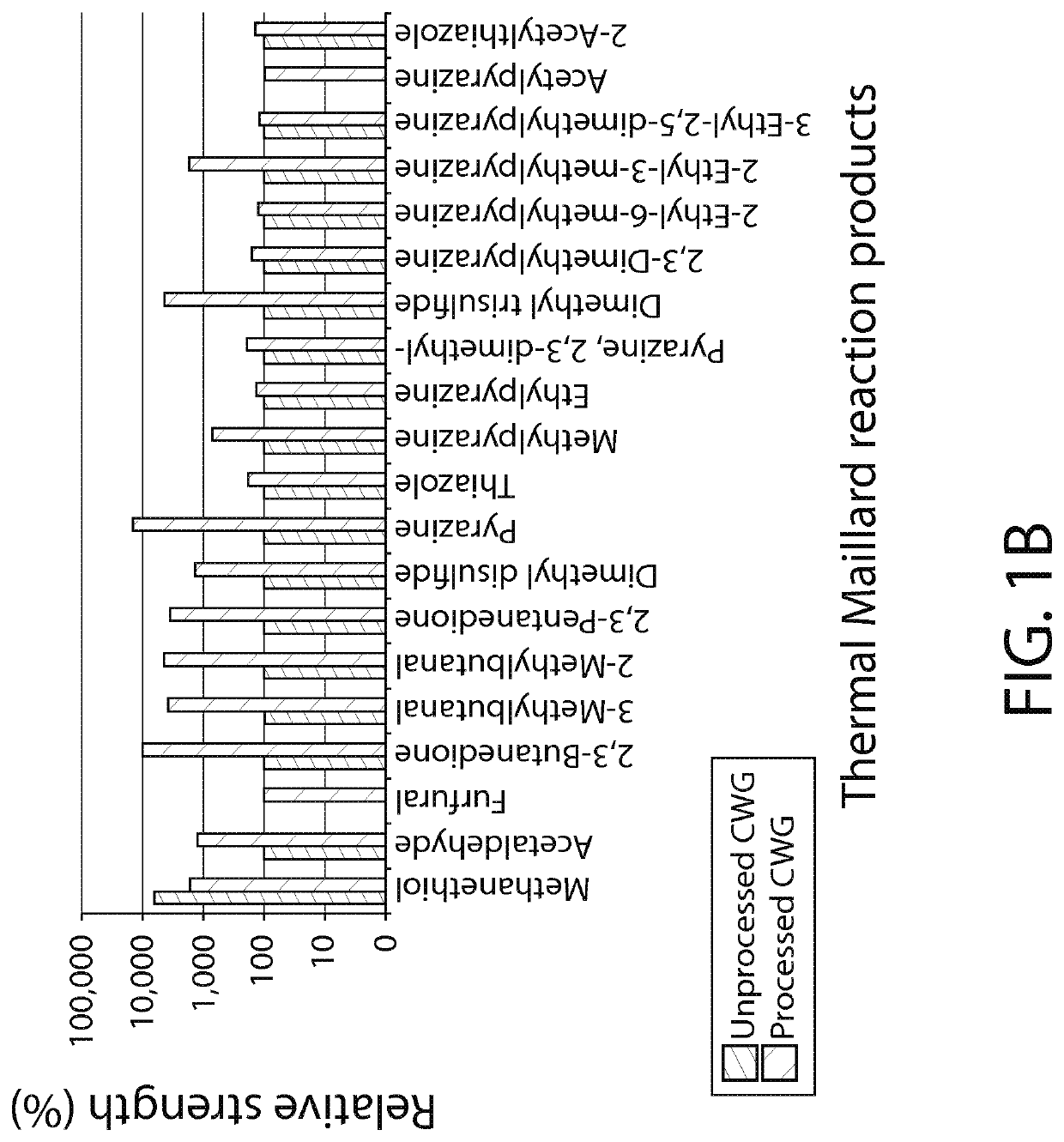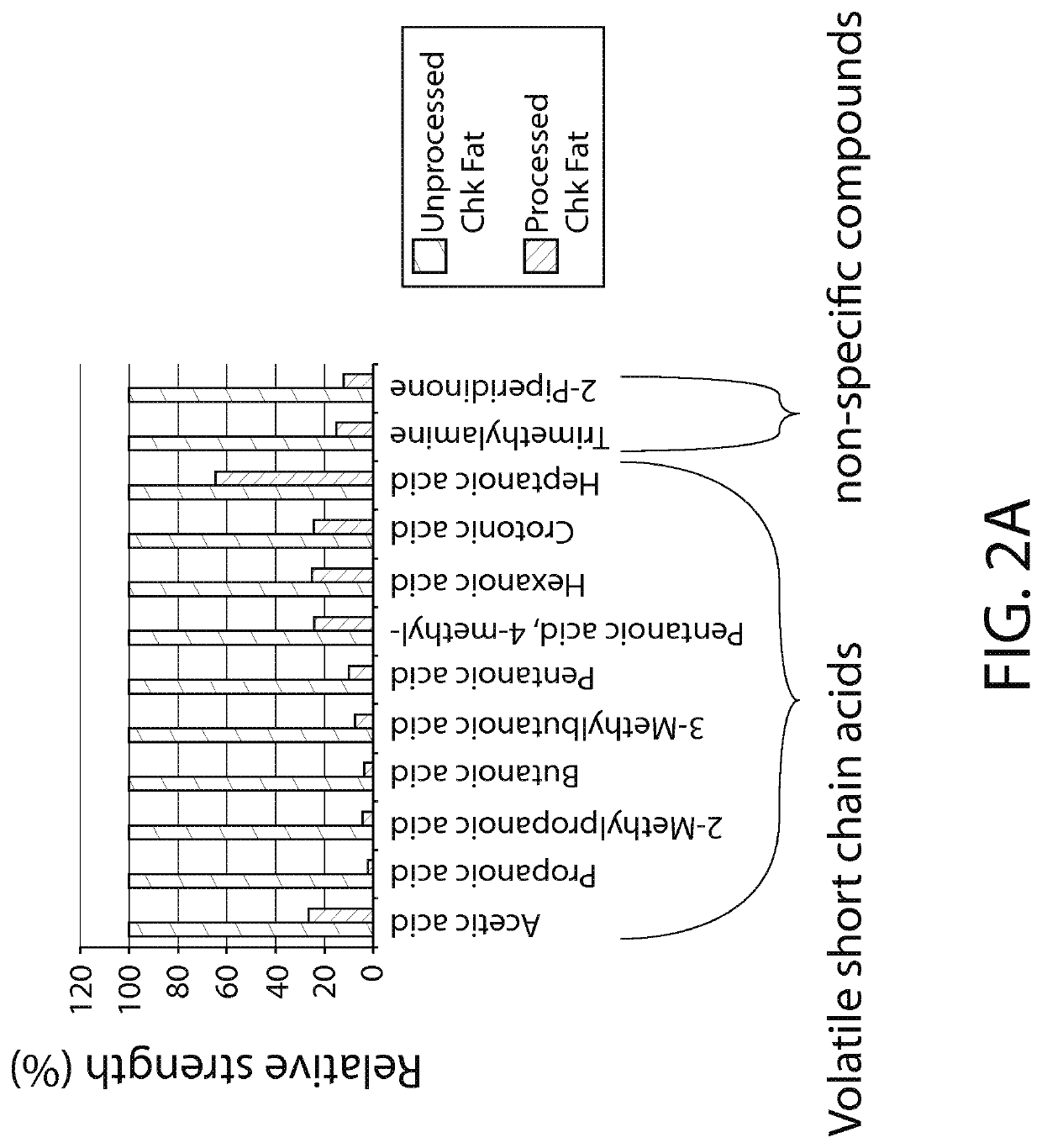Method of preparing palatability enhancer
a palatability enhancer and enhancer technology, applied in the field of palatability enhancers, can solve the problems of undesirable, dark appearance, strong and offensive odor of fats derived from these materials, etc., and achieve the effect of reducing undesirable odors and altering the taste characteristics of fa
- Summary
- Abstract
- Description
- Claims
- Application Information
AI Technical Summary
Benefits of technology
Problems solved by technology
Method used
Image
Examples
example 1
Processing of Animal Fat
[0155]A pork fat (Choice White Grease)-based mixture according to Table 2 was processed by the method described herein to obtain processed fat suitable for canine consumption (referred to hereinafter as “BBQ fat”), and a premium chicken-fat based mixture according to Table 3 was processed by the method described herein to obtain processed fat suitable for feline consumption (referred to hereinafter as “Roasted Chicken Fat”). In the composition of Table 2 for dogs, the edible agents (in particular, yeast extract, alanine, glycine, thiamine and smoke flavor) were specifically selected to mimic bacon flavor. In the composition of Table 3 for cats, the edible agents (in particular, dextrose, yeast extract, methionine, cysteine and thiamine) were specifically selected to mimic the aroma profile of broiled chicken.
[0156]
TABLE 2pork fat mixture for dogsAmount (wt % by totalIngredientweight of mixture)Choice White Grease87-90Water10-12Yeast flavorant0.5-0.8Smoke flav...
example 2
Appearance of Processed Fat
[0159]A color analysis of the processed fat obtained in Example 1 was conducted and compared to untreated fat. The method of the present invention improves the appearance of pork fat by brightening up the color of the raw material. In particular, it was observed that the processed fat (BBQ pork fat) was less “cloudy” than the untreated control. This is illustrated in FIG. 1. The cloudiness may be attributed to proteinaceous residues from rendering and sediments of spent flavor reactants. These were removed in the centrifugation step. The color change was further confirmed by measuring Hunter's color values as shown in Table 4. The brightness of BBQ Pork Fat (54.1) is significantly higher than that of non-treated Pork Fat (40.0). The color of the BBQ Pork Fat is a stronger yellow and has less red hues as expressed by its higher Hunter's a value (13.3) and lower Hunter's b value (39.1) than that of untreated pork fat (a=11.6 and b=46.9). The color measuremen...
example 3
Microbial Activity
[0161]The process of the present invention improves the food safety of animal fats by its capability to eliminate microbial contaminants in the ingredient. The raw animal fat sample (Premium Chicken Fat (M0710)) was spiked with 4.2×106 cfu / g non-pathogenic aerobic microorganisms as illustrated in Table 5. After subjecting the fat to the process of Example 1, the processed Roasted Chicken Fat had no detectable aerobic microorganisms (<10 cfu / g). This confirms that the method of the present invention is capable of removing totally the microbial contaminants in the spiked raw material. As mentioned above, fat tends to encapsulate and insulate microorganisms, which are consequently very difficult to deactivate by dry heat. By introducing the aqueous flavor blend, the method of the present invention is able to remove all microbial contaminants, and thus improve the food safety of the raw material.
[0162]
TABLE 5Total aerobic plate counts in different fat samplesSampleTota...
PUM
 Login to View More
Login to View More Abstract
Description
Claims
Application Information
 Login to View More
Login to View More - R&D
- Intellectual Property
- Life Sciences
- Materials
- Tech Scout
- Unparalleled Data Quality
- Higher Quality Content
- 60% Fewer Hallucinations
Browse by: Latest US Patents, China's latest patents, Technical Efficacy Thesaurus, Application Domain, Technology Topic, Popular Technical Reports.
© 2025 PatSnap. All rights reserved.Legal|Privacy policy|Modern Slavery Act Transparency Statement|Sitemap|About US| Contact US: help@patsnap.com



